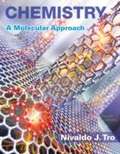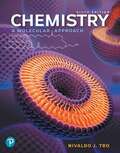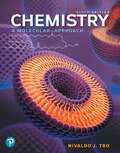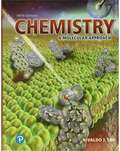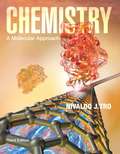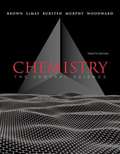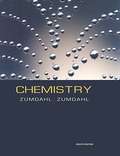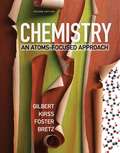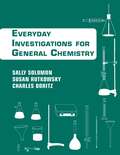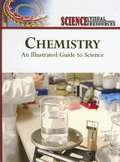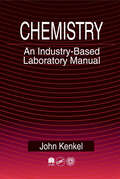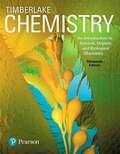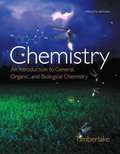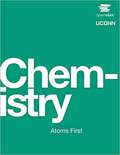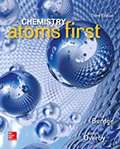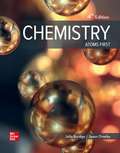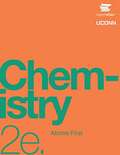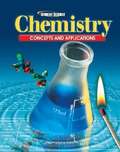- Table View
- List View
Chemistry: A Molecular Approach
by Nivaldo J. TroThe Fourth Edition of Niva Tro's Chemistry: A Molecular Approach reinforces development of 21st century skills including data interpretation and analysis, problem solving and quantitative reasoning, applying conceptual understanding to new situations and peer-to-peer collaboration. Nivaldo Tro presents chemistry visually through multi-level images-macroscopic, molecular, and symbolic representations-helping readers see the connections between the world they see around them (macroscopic), the atoms and molecules that compose the world (molecular), and the formulas they write down on paper (symbolic). The benefits of Dr. Tro's problem-solving approach are reinforced through digital, Interactive Worked Examples that provide an office-hour type of environment and expanded coverage on the latest developments in chemistry. New Key Concept Videos explain difficult concepts while new end-of-chapter problems including Group Work questions and Data Interpretation and Analysis questions engage readers in applying their understanding of chemistry. The revision has been constructed to easily incorporate material to engage readers.
Chemistry: A Molecular Approach
by Nivaldo J. TroChemistry: A Molecular Approach presents chemistry visually through macroscopic, molecular and symbolic multi-level images to help you see the connections between chemistry and the world around you. Author Nivaldo Tro uses a consistent problem-solving approach (Sort, Strategize, Solve and Check) throughout the text to show how to analyze a problem and devise a solution strategy. His consistent problem-solving approach and active learning resources are designed to engage you in becoming an expert problem solver and critical thinker. <p><p>The 6th Edition presents interactive digital features to guide you through key concepts and the problem-solving process. Updates reflect current research on the COVID-19 vaccine and an extensive diversity, equity and inclusion review.
Chemistry: A Molecular Approach
by Nivaldo J. TroChemistry: A Molecular Approach presents chemistry visually through macroscopic, molecular and symbolic multi-level images to help you see the connections between chemistry and the world around you. Author Nivaldo Tro uses a consistent problem-solving approach (Sort, Strategize, Solve and Check) throughout the text to show how to analyze a problem and devise a solution strategy. His consistent problem-solving approach and active learning resources are designed to engage you in becoming an expert problem solver and critical thinker. The 6th Edition presents interactive digital features to guide you through key concepts and the problem-solving process. Updates reflect current research on the COVID-19 vaccine and an extensive diversity, equity and inclusion review.
Chemistry: A Molecular Approach
by Nivaldo TroNivaldo Tro’s Chemistry: A Molecular Approach presents chemistry visually through multi-level images―macroscopic, molecular, and symbolic representations―to help students see the connections between the world they see around them, the atoms and molecules that compose the world, and the formulas they write down on paper. Interactive, digital versions of select worked examples instruct students how to break down problems using Tro’s unique “Sort, Strategize, Solve, and Check” technique and then complete a step in the example. To build conceptual understanding, Dr. Tro employs an active learning approach through interactive media that requires students to pause during videos to ensure they understand before continuing. <p><p>The 5th Edition pairs digital, pedagogical innovation with insights from learning design and educational research to create an active, integrated, and easy-to-use framework. The new edition introduces a fully integrated book and media package that streamlines course set up, actively engages students in becoming expert problem solvers, and makes it possible for professors to teach the general chemistry course easily and effectively.
Chemistry: A Molecular Approach (AP Edition)
by Nivaldo J. TroA student oriented book that provides relevant information that will motivate and get them to achieve the highest possible level in chemistry.
Chemistry: A Molecular Approach, 3rd Edition
by Nivaldo J. TroChemistry: A Molecular Approach, Third Edition is an innovative, pedagogically driven text that explains challenging concepts in a student-oriented manner. Nivaldo Tro creates a rigorous and accessible treatment of general chemistry in the context of relevance and the big picture. Chemistry is presented visually through multi-level images-macroscopic, molecular, and symbolic representations-helping students see the connections between the world they see around them (macroscopic), the atoms and molecules that compose the world (molecular), and the formulas they write down on paper (symbolic). The hallmarks of Dr. Tro's problem-solving approach are reinforced through interactive media that provide students with an office-hour type of environment built around worked examples and expanded coverage on the latest developments in chemistry. Pioneering features allow students to sketch their ideas through new problems, and much more.
Chemistry: AP Edition (10th Edition)
by Theodore L. Brown H. Eugene Lemay Jr. Bruce E. BurstenThis is the tenth edition of a text that has enjoyed unprecedented success as an AP* program over its many editions. It is fair to ask why there needs to be yet another edition. The answer in part lies in the nature of chemistry itself, a dy¬namic science in a process of continual discovery. New research leads to new applications of chemistry in other fields of science and in technology. A text¬book that purports to introduce chemistry to AP* students who have only a limited prior acquaintance with it should reflect that dynamic, changing char¬acter.
Chemistry: AP Edition (11th edition)
by Theodore L. Brown H. Eugene Lemay Jr. Bruce E. Bursten Catherine J. Murphy Patrick WoodwardChemistry: The Central Science, Eleventh Edition, has been written to introduce you to modern chemistry.
Chemistry: AP Edition (12th Edition)
by Theodore L. Brown H. Eugene Lemay Jr. Bruce E. Bursten Catherine J. Murphy Patrick WoodwardTrusted, innovative, and calibrated, Chemistry: The Central Science has helped millions of students understand and succeed in general chemistry. Its unrivaled problems, scientific accuracy, and clarity are maintained in this new edition, which is the book's biggest revision to date. In the Twelfth Edition,every word and piece of art has been studied for effectiveness. Based on feedback from students like you, this revision reflects the unparalleled expertise of its author team; each chapter has been updated and streamlined to remove any content not proven to increase student comprehension. Joined in this edition by new co-author Patrick Woodward, the book's solid authorship gains a fresh, new perspective yet maintains its unified, consistent voice.
Chemistry: Advanced Placement Edition
by Steven S. Zumdahl Susan A. ZumdahlCHEMISTRY allows the reader to learn chemistry basics quickly and easily by emphasizing a thoughtful approach built on problem solving. For the Eighth Edition, authors Steven and Susan Zumdahl have extended this approach by emphasizing problem-solving strategies within the Examples and throughout the text narrative. CHEMISTRY speaks directly to the reader about how to approach and solve chemical problems--to learn to think like a chemist--so that they can apply the process of problem-solving to all aspects of their lives.
Chemistry: An Atoms-focused Approach
by Thomas R. Gilbert Rein V. Kirss Natalie Foster Stacey Lowery BretzThe Second Edition's new co-author, Stacey Lowery Bretz, uses visualization tools--based on Chemistry Education Research, and focused on the particulate nature of matter--to help students self-assess what they know before, during, and after each chapter. Smartwork5 allows instructors to use this pedagogy as a diagnostic, and students receive hints and answer-specific feedback within the text.
Chemistry: An Everyday Approach To Chemical Investigation
by Sally Solomon Susan Rutkowsky Charles BoritzChemistry: An Everyday Approach to Chemical Investigation is intended to accompany any mainstream general chemistry course, and consists of 27 experiments that can be completed using only chemicals found in consumer products. The manual is an ideal resource for courses emphasizing green chemistry in which the use of hazardous materials is reduced or eliminated altogether. Many of the experiments requiring simple equipment and glassware can be performed at remote sites providing laboratory experience for use with on-line or long distance learning courses. The advantages of using accessible materials in chemistry laboratory are considerable. Students can reinforce lecture discussions while working with familiar materials. For instructors, assembling the chemicals required for a lab course can be accomplished with limited budgets and without access to a chemical company. Problems with safety and waste disposal are significantly reduced.
Chemistry: An Illustrated Guide to Science
by Derek McmonagleEach page of the textbook features detailed illustrations and extensive captions, a box of key words that are further explained in the text or in the glossary, and bulleted text that elaborates the topics depicted by the artwork.
Chemistry: An Industry-Based Laboratory Manual
by John KenkelHave you ever had a discussion with an industrial chemist about the job? Have you ever shadowed a chemist or chemical technician in an industrial or government laboratory for a day? If you have done these things, you were likely surprised at how foreign the language seemed or startled at how unfamiliar the surroundings were. Was there any talk of t
Chemistry: An Introduction To General, Organic, And Biological Chemistry
by Karen TimberlakeChemistry: An Introduction to General, Organic, and Biological Chemistry, 13th Edition is the ideal resource for anyone interested in learning about allied health. Assuming no prior knowledge of chemistry, author Karen Timberlake engages readers with her friendly presentation style, revealing connections between the structure and behavior of matter and its role in health and the environment. Aiming to provide a better learning experience, the text highlights the relevance of chemistry through real-world examples. Activities and applications throughout the program couple chemistry concepts with health and environmental career applications to help readers understand why the content matters. The text also fosters development of problem-solving skills, while helping readers visualize and understand concepts through its engaging figures, sample problems, and concept maps. The 13th Edition expands on Karen Timberlake’s main tenets: relevance, a clinical focus, educational research, and learning design. New applications added to questions and problem sets emphasize the material’s relevance, while updated chapter openers with follow-up stories help readers form a basis for making decisions about issues concerning health and the environment. New problem-solving tools in this edition, including Try it First and Connect, urge readers to think critically about problem-solving while learning best practices.
Chemistry: An Introduction to General, Organic, and Biological Chemistry (12th Edition)
by Karen C. TimberlakeFor one-semester courses in General, Organic, and Biological Chemistry Show the importance of chemistry in the real world Chemistry: An Introduction to General, Organic, and Biological Chemistry, Twelfth Edition is the ideal resource for today's allied health students. Assuming no prior knowledge of chemistry, author Karen Timberlake engages students through her friendly presentation style and reveals connections between the structure and behavior of matter and its role in health and the environment.
Chemistry: Atoms First
by Richard Langley Edward J. Neth Pau Flowers Klaus Theopold William R. RobinsonOFFICIAL PRINT VERSION: OpenStax OER official printed textbooks, published by XanEdu Publishing (XanEdu is OpenStax official print provider), ships from and sold by Amazon.com ABOUT THIS BOOK: This is the most affordable printed OpenStax book available. As an OpenStax Partner we print all OpenStax textbooks with a unique soft cover and BW interior pages. The textbook content is exactly the same as the free digital OpenStax book (Digital ISBN\-13: 978\-1\-947172\-18\-0). This textbook is available for free download at the OpenStax website, but as many students prefer the convenience of a printed book, we offer this book in partnership with OpenStax to provide an affordable printed option for college students. BOOK SUMMARY: Chemistry: Atoms First is a peer\-reviewed, openly licensed introductory textbook produced through a collaborative publishing partnership between OpenStax and the University of Connecticut and UConn Undergraduate Student Government Association. This title is an adaptation of the OpenStax Chemistry text and covers scope and sequence requirements of the two\-semester general chemistry course. Reordered to fit an atoms first approach, this title introduces atomic and molecular structure much earlier than the traditional approach, delaying the introduction of more abstract material so students have time to acclimate to the study of chemistry. Chemistry: Atoms First also provides a basis for understanding the application of quantitative principles to the chemistry that underlies the entire course. ABOUT OPENSTAX: OpenStax course materials are the most widely used OER textbooks in the world. Always free in digital format, the books are also available low cost in full\-color hardcover and B\x26W paperback print formats.
Chemistry: Atoms First
by Julia Burdge Jason OverbyThe Atoms First approach provides a consistent and logical method for teaching general chemistry. This approach starts with the fundamental building block of matter, the atom, and uses it as the stepping stone to understanding more complex chemistry topics. Once mastery of the nature of atoms and electrons is achieved, the formation and properties of compounds are developed. Only after the study of matter and the atom will students have sufficient background to fully engage in topics such as stoichiometry, kinetics, equilibrium, and thermodynamics. Thus, the Atoms First approach empowers instructors to present the most complete and compelling story of general chemistry. Far from a simple re-ordering of topics, this is a book that will truly meet the needs of the growing atoms-first market. The third edition continues to build on the innovative success of the first and second editions. Changes to this edition include specific refinements intended to augment the student-centered pedagogical features that continue to make this book effective and popular both with professors, and with their students.
Chemistry: Atoms First
by Julia Burdge Jason OverbyThe fourth edition of Chemistry: Atoms First by Burdge and Overby builds further on the success of the first three editions. Changes to this edition focus on new additions to the pedagogy, refinement of the current approach, and other innovations driven by feedback from instructors and students alike.
Chemistry: Atoms First
by OpenStaxChemistry: Atoms First 2e is a peer-reviewed, openly licensed introductory textbook produced through a collaborative publishing partnership between OpenStax and the University of Connecticut and UConn Undergraduate Student Government Association. This text is an atoms-first adaptation of OpenStax Chemistry 2e. The intention of “atoms-first” involves a few basic principles: first, it introduces atomic and molecular structure much earlier than the traditional approach, and it threads these themes through subsequent chapters. This approach may be chosen as a way to delay the introduction of material such as stoichiometry that students traditionally find abstract and difficult, thereby allowing students time to acclimate their study skills to chemistry. Additionally, it gives students a basis for understanding the application of quantitative principles to the chemistry that underlies the entire course. It also aims to center the study of chemistry on the atomic foundation that many will expand upon in a later course covering organic chemistry, easing that transition when the time arrives. The second edition has been revised to incorporate clearer, more current, and more dynamic explanations, while maintaining the same organization as the first edition. Substantial improvements have been made in the figures, illustrations, and example exercises that support the text narrative.
Chemistry: Bullet Guides
by Helen HardenOpen this book and you will- Make sense of the elements- Grasp critical concepts- Fill gaps in your knowledge- Pass Chemistry!
Chemistry: Concepts And Applications
by Mcgraw-Hill StaffChemistry: Concepts and Applications is a conceptual approach to the presentation of chemistry. It has a clear and comprehensive narrative of chemistry concepts with just the right amount of math. Two of many in-text lab options include Launch Labs and Try at Home Labs, the latter of which are unique to Glencoe. The program's media/technology support diverse classroom instruction.
Chemistry: Concepts and Applications
by Cheryl Wistrom John S. Phillips Victor S. StrozakChemistry: Concepts and Applications is a conceptual approach to the presentation of chemistry. It has a clear and comprehensive narrative of chemistry concepts with just the right amount of math.
Chemistry: Concepts and Applications
by Mcgraw-Hill StaffChemistry: Concepts and Applications is a conceptual approach to the presentation of chemistry. It has a clear and comprehensive narrative of chemistry concepts with just the right amount of math. Two of many in-text lab options include Launch Labs and Try at Home Labs, the latter of which are unique to Glencoe. The program's media/technology support diverse classroom instruction.
